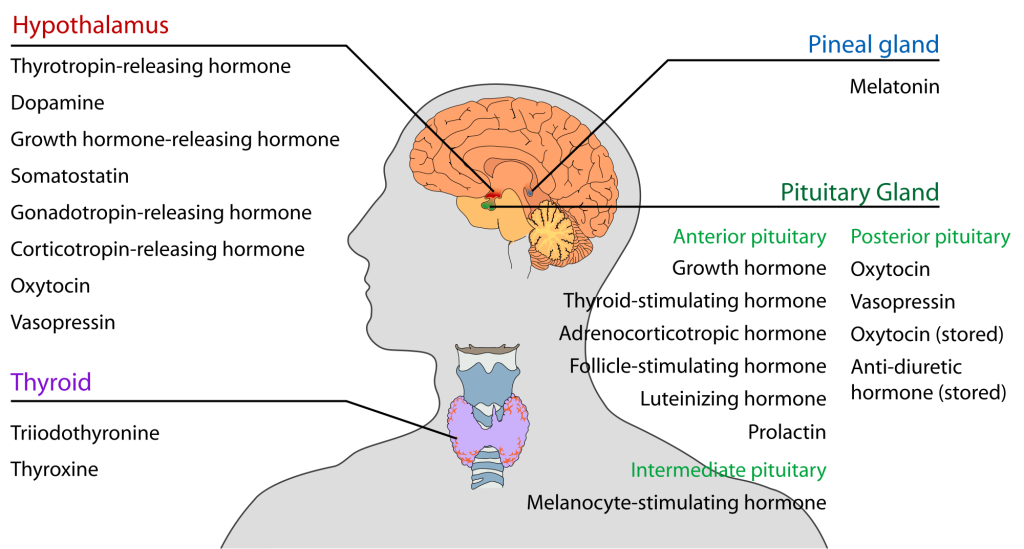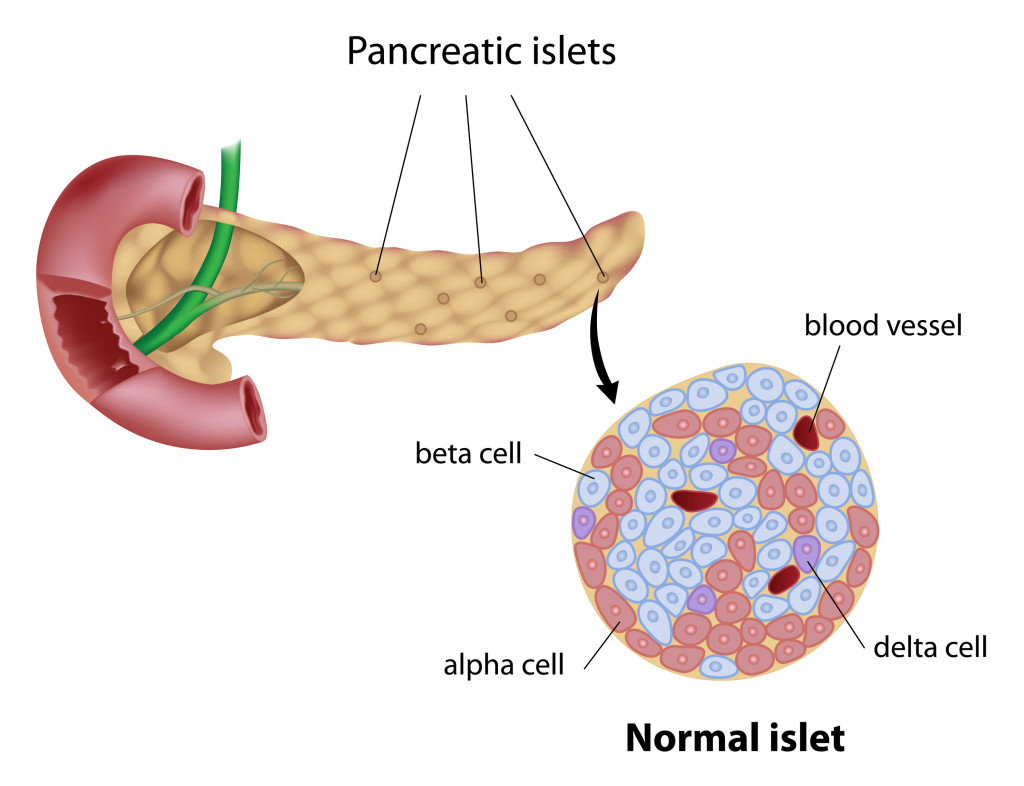Sadly, the endocrine system takes a back seat to the other systems of the body. However, without the endocrine system, our body would not be able to carry out many of its functions.
What Exactly Is the Endocrine System?
The endocrine system is a system of glands in the body that produce and secrete hormones. The influence of this system is expansive. In one way or another, each organ of the body is affected by it. Hormones are responsible for a number of things from temperature regulation to our moods to metabolism and development of other organs.
Now, the next question would be what glands/organs are the key players?
The Key Players (Endocrine Glands)

- Hypothalamus
- Pituitary gland
- Thyroid
- Parathyroid glands
- Adrenal glands
- Pineal gland
- Pancreas
- Ovaries and Testes
Hypothalamus
The hypothalamus is the head of the endocrine system. Its function in the endocrine system is to control and stimulate the pituitary gland. The hypothalamus and pituitary gland are connected via a system of blood vessels, which is called a portal system. Hormones produced in the hypothalamus travel through the portal system and stimulate the pituitary gland. The hypothalamus produces inhibiting or releasing hormones.
Pituitary Gland
The tiny pituitary gland is the next stop. It is located at the base of the brain. This gland is often referred to as the “master gland” because it is able to regulate the other glands by determining the amount of hormones that need to be secreted into the bloodstream. The pituitary gland has two parts: the anterior lobe and posterior lobe.
The posterior lobe is the smaller of the two, and stores/secretes two hormones. Oxytocin is one of the hormones and it causes the contraction of the uterus during childbirth. The second hormone is antidiuretic hormone or ADH. You will also see ADH called vasopressin.
ADH is made in the hypothalamus but goes to the posterior pituitary gland for storage. ADH has a role in blood pressure and water balance. The anterior pituitary produces seven hormones. The first four are tropic hormones, meaning that they stimulate other hormone-producing glands. These hormones are thyroid-stimulating hormone (TSH), follicle-stimulating hormone (FSH), luteinizing hormone (LH), and adrenocorticotropic hormone (ACTH). FSH and LH are responsible for the stimulation of the sex glands, while ACTH stimulates the adrenal glands.
The other four hormones are prolactin, growth hormone (GH), and melanocyte-stimulating hormone (MSH). Prolactin stimulates milk production, MSH stimulates the skin cells to produce melanin and GH aids in bone growth and increased muscle mass. All of this is regulated by the hypothalamus.
Thyroid
Our thyroid is probably the gland everyone is most familiar with. It is located in the neck and stimulated by TSH, which is appropriately called thyroid-stimulating hormone. The thyroid is responsible for metabolism, regulating body temperature, the development of the nervous system, reproductive system, and heart function. The thyroid secretes two hormones, T3 and T4, which are collectively called TH (thyroid hormone).

Parathyroid Glands
The parathyroid glands are 4 small glands located just behind the thyroid. The hormone produced by this gland is easy to remember. It is simply called PTH, which is short for parathyroid hormone. PTH regulates calcium levels by stimulating the bones to release more of it when levels in the bloodstream become too low.
Adrenal Glands

The adrenal glands sit just above our kidneys. Whenever you feel stressed out, you can thank this guy. The outer adrenal gland, or adrenal cortex, is made of glandular tissues. This portion produces steroids: mineral corticosteroids, glucocorticosteroids, androgen, and estrogen.
The adrenal cortex is made of three regions. The zona granulosa secretes mineralocorticoids and regulates mineral levels. Zona fasciculata helps us deal with stress by secreting corticosteroids. Androgens are produced in the zona reticularis. These androgens are much weaker than those produced in the sex glands. Androgens initiate the growth of pubic hair during puberty.
The adrenal medulla (inner adrenal gland) is responsible for releasing epinephrine and norepinephrine during stressful situations.
Pineal Gland
The pineal gland is a teeny tiny gland located in the center of the brain. It produces melatonin, which is what makes us feel sleepy. During the day, melatonin levels are lower than at night. Our visual pathways stimulate an area of the hypothalamus called the suprachiasmatic nucleus. The suprachiasmatic nucleus signals the pineal gland through nerves located near the spinal cord.
Pancreas
The pancreas is not only part of the digestive system, but it is also part of the endocrine system. Insulin and glucagon are secreted by the pancreas to regulate blood sugar levels. Among the cells used for digestion, are cells that produce hormones. These cells are called islets of Langerhans, of which there are four types. Each type secretes a different hormone.

Alpha (α) cells secrete glucagon, which elevates the level of glucose in the blood. Beta (β) cells secrete insulin, which decreases the level of glucose. A hormone called somatostatin, secreted by delta (δ) cells, regulates the α and β cells. The fourth type of cell is called an F cell. F cells secrete a polypeptide that inhibits the digestive enzymes produced in the pancreas.
Ovaries and Testes
Last and certainly not least, are the ovaries and testes. In females, the important hormones are estrogen and progesterone. Both are produced in the ovaries. They regulate the menstrual cycle and initiate production of eggs. Granulosa cells in the ovaries produce estrogen and progesterone. Interstitial cells in the testes produce testosterone, which is the important sex hormone in males. Testosterone is responsible for sperm production and developing the secondary sexual traits.
How it Works
Hormone release can be triggered in three ways: levels of hormone in the blood, nerve stimulation and other hormones. In some cases, low levels of certain nutrients in the blood can trigger a gland to release a hormone. Although rare, hormone release can be stimulated by the nervous system. This occurs in the medulla, which releases adrenaline.
This type of stimulation is sporadic and does not have a pattern. The final way hormone release can be triggered is based on the presence of other hormones. The best example of this is the interaction between the hypothalamus and the pituitary gland. The hormones released from the hypothalamus travel through the portal system and direct the pituitary gland to secrete hormones. In turn, the hormones released by the pituitary gland stimulate other glands.
Hormone Regulation
Hormones need to be regulated in order to maintain homeostasis. Otherwise, levels would become too high or too low.
Our body has two methods for this: negative feedback and positive feedback. The negative feedback loop is more commonly used and is pretty simple. When a hormone reaches the optimal level in the bloodstream, a signal is sent to the hypothalamus and pituitary gland. This signal stops the production of the hormone and the levels begin to decrease.
The opposite situation can also occur. If hormone levels are too low, the hypothalamus and pituitary gland can signal glands to produce more of the needed hormone. The positive feedback loop is used less frequently. In this case, the effect of the hormone becomes more intense as the levels increase. This happens during childbirth. As hormone levels increase, labor progresses and becomes more intense.
Conclusion
As you can see, the endocrine system covers a lot of key functions in our body. Hormones can maintain homeostasis, aid in reproduction and even have a role in sleep. The system that seems to be forgotten about has a pretty large role. Hormones themselves can get even more complex, but that is a topic for another article.

Great explanation, easy to understand. My book also includes the thymus glad in the endocrine system though. Thank you for taking your time to explain this.
Love it love It love it!!!!